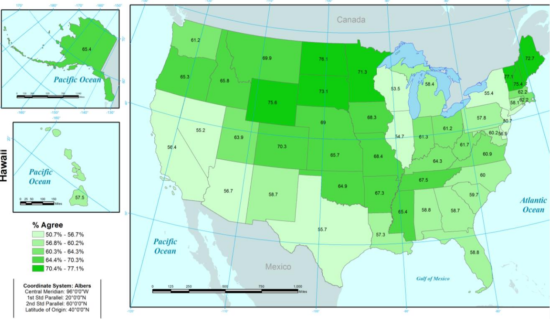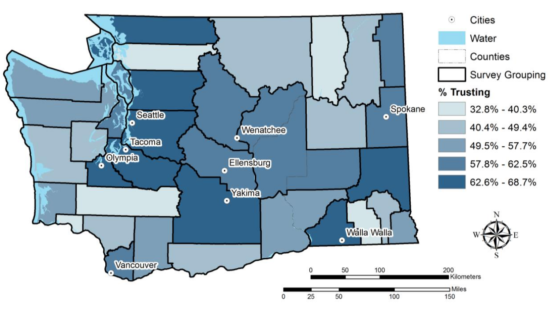
Survey Measures Washingtonian’s Trust In WDFW, Wildlife Values
More Washingtonians trust fish and wildlife managers to make good decisions than they do of either the federal or state government.
Sixty-one percent say they are confident in WDFW practically all or most of the time — including 59.8 percent of hunters and anglers — while only 43 percent of state residents trust Olympia and just 20 percent have faith in Washington D.C.

In an era of widespread declining trust in government, it represents a rise of nearly 4 percent for WDFW since a 2004 measurement.
While it may not seem like it squares with all the comments the agency gets deluged with on its Facebook page whenever posting something even mildly controversial, the numbers come from the 132-page Washington chapter of the 2019 America’s Wildlife Values survey of all 50 states.
A joint Colorado State University, Ohio State University and Responsive Management project, it reflects the thoughts of 2,755 residents everywhere from Ilwaco to Ione, Carlsborg to Rogersburg.
They responded mostly by filling out and mailing in questionnaires, though some participated via the web. No margin of error is stated in the state or national reports.
Results will be presented to the state Fish and Wildlife Commission at its Aug. 2-3 meeting.
“The purpose of the America’s Wildlife Values Project was to assess the social context of wildlife management in the U.S. in an attempt to understand this conflict,” reads a WDFW summary. “It is the first-ever study that describes how U.S. residents across all 50 states (including Washington), and within each state separately, think about wildlife. The project provides insight into the mix of values that publics have toward wildlife, how this mix of values contributes to conflict over policy issues, and how changing societal conditions are affecting wildlife management across the country. The study also assesses the culture of state fish and wildlife agencies and, when combined with the public assessment, allows us to explore the dynamics between agency culture and public values.”
It makes for interesting reading, as there are also questions about future funding of wildlife management, importance of habitat work, acquisition of recreational lands, lethal removals of predators and other issues, breaking things down at the county level and whether those polled identified as traditionalist, pluralist, mutualist or distanced from wildlife.

Washingtonian’s trust in WDFW ranked at about the midpoint among all the states, with Northern Plains and New England residents the most confident in their state fish and wildlife agencies, (Vermont: 77.1 percent; North Dakota, 76.1 percent; Wyoming, 75.6 percent; New Hampshire, 75.4 percent; South Dakota, 73.1 percent), according to the authors’ national results.
Central Midwest and Mid-Atlantic state residents had the lowest faith (New Jersey, 50.7 percent; Wisconsin, 53.5 percent; Illinois, 54.7; Nevada, 55.2 percent; New York, 55.4 percent).
As for other states of regional interest, 69.9 percent of Montanans trust FWP, 65.8 percent of Idahoans trust IDFG, 65.4 percent of Alaskans trust ADFG, 65.3 percent of Oregonians trust ODFW and 56.4 percent of Californians trust CDFW.
Back in Washington, WDFW trust was highest among residents of I-5 corridor counties from Whatcom down to Thurston (except, notably, Skagit) plus Clark, and on the Eastside in Walla Walla, Whitman and Yakima Counties.
It was lowest in Skagit, Lewis, Wahkiakum, Ferry and Columbia Counties.

The survey found that 14.0 percent of Washington hunters and anglers “almost always” trust WDFW, 45.8 percent do “most of the time,” 30.9 percent “only some of the time,” and 9.3 percent “almost never.”
Interestingly, sportsmen are more trusting of the federal government than residents as a whole (27 percent vs. 19 percent), but it’s the opposite with state government (40 percent vs. 44 percent), perhaps a reflection of politics.
On wolves, it found 29 percent statewide support for removing livestock-killing wolves, 44 percent among sportsmen and strongest approval among the three easternmost Blue Mountains counties plus Ferry and Lincoln, weakest in King, Pierce and Jefferson Counties where there are no known wolves.
With WDFW staffers recommending that the Fish and Wildlife Commission not pursue another fee increase this coming legislative session and instead ask for more sales tax infusions to cover emerging and other needs in the supplemental budget proposal, the survey also includes results of note on agency funding.
It finds strong support among both sportsmen and nonsportsmen to use General Fund revenues and a “portion of sales tax on outdoor equipment” for nongame management.
Earlier this year a bill that would have added a .20 percent tax on certain recreational gear and clothing over $200 to help fund the upkeep of WDFW-owned fish and wildlife habitat received a hearing in Olympia.
It didn’t move any further, but technically with how the legislature works, the bipartisan HR 2122 is still alive.
Ultimately, the Washington chapter and the national study represent a look at long-term trends in society’s thinking on fish and wildlife and their management that are “having, and will continue to have, significant influence on the wildlife profession in the U.S.: shifting social values toward wildlife.”
Along with the 4 percent increase in trust in WDFW since 2004’s survey, confidence also rose 8 percent — the largest jump of any state — in ODFW, 5 percent for Wyoming Game & Fish, 4 percent for ADFG and 3 percent for IDFG.
But it sagged 11 percent for Nevada’s fish and wildlife managers, 10 percent for Texas’s and 9 percent for Arizona’s.
Washingtonian’s trust in state government barely budged over 18 years, holding at 43 percent, but with the feds it dropped from 33 percent to 20 percent over that same period, perhaps a reflection of political frustration the whole way around.
The survey’s national piece includes a set of recommendations:
“Our findings might be particularly relevant in considering ways to engage a broader array of stakeholders, sustaining an effective agency culture, meeting diverse values with new funding, developing management strategies that fit with cultural values, bringing the value contrast into consensus-building in dealing with human-wildlife conflict, etc. The data may also be useful in framing more geographically and time-specific initiatives in areas such as communication, outreach, and regulatory decision-making.”
Get a Free NewsLetter Here
[hubspot type=form portal=5325588 id=614ee0f1-9297-4340-b0f4-5b40dfd45220]

